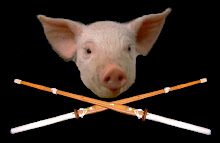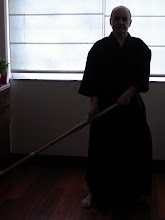Of the sharp swords used for iaido practice, not all but a large majority will have been forged and bought as a pre-existing stock item and not tailored to the user. I would thus now like to look in to the specifications swords in general, and these pre-produced blades in particular, for the reference of all practitioners of the sword arts.Japanese swords are categorised into four historical periods depending on when they were forged. These are koto (lit: old swords, forged before 1596), shinto (lit: new swords forged between 1596 and 1760), shin shinto (lit: new new swords, forged between1761 and 1876) and gendaito (lit: modern era swords, forged from 1887 onwards).Among modern day iaido practitioners there are not many who own a sword that is well balanced for them personally and I would estimate that around seventy percent are not using suitable blades.I would thus like to consider this point in general, looking to my own experiences with tameshigiri.There are very few swords in existence that fit well with their user and are balanced in just the way they require to move naturally and harmoniously. Most are forged by swordsmiths using their own unique methods and to their own stock specifications and modern day iaido practitioners will try to adapt their technique to the idiosyncrasies of the blade in their training.Using a badly balanced sword is a prime cause of the holes in technique that can be seen in many aspects of a swordsman’s performance at demonstrations. One wonders how many of those training in iai bear in mind the following points when selecting a sword:
1. Blade length
2. Weight
3. Curvature
4. Overall appearance of the sword
5. Blade width
6. Nature of the hamon
7. Cutting ability
8. Flexibility of the blade
9. Positioning of the menuki ornaments
10. Positioning of the holes for the pegs that secure the hilt to the blade (mekugi ana and hikae mekugi ana)
11. The length of the tang
12. The practicality of the fittings.
2. Weight
3. Curvature
4. Overall appearance of the sword
5. Blade width
6. Nature of the hamon
7. Cutting ability
8. Flexibility of the blade
9. Positioning of the menuki ornaments
10. Positioning of the holes for the pegs that secure the hilt to the blade (mekugi ana and hikae mekugi ana)
11. The length of the tang
12. The practicality of the fittings.
1. Length
The standard length for sword blades as specified by the Tokugawa bakufu was two shaku and three sun (approximately 70 centimetres), with variations of between two shaku and two shaku and five sun depending on the height of the user.The standard length of the military swords (gunto) issued by the old Imperial Army and Navy was two shaku and two sun (approximately 67 centimeters).The swords used in modern iaido practice are generally between two shaku and three sun and two shaku and five sun (between 70 centimetres and 75 centimetres) with swords longer than this only being used by special individuals. If attempting tameshigiri using a sword longer than this, and the blade turns out to be slightly weak, it can snap clean off from the rebound of the strike, especially if the cut is made at an incorrect angle or trajectory.The great master of iaido Nakayama Hakudo sensei stated that the appropriate length for a sword is that a length of one’s own height minus three shaku (around 90 centimetres). In my case I am five shaku and four sun (approximately 165 centimetres) in height, and so this would mean that a blade of two shaku and four sun (approximately 73 centimetres) is optimal. However, this length is only optimal for solo iaido kata cutting the air and is slightly too long for tameshigiri. As the wielder stands up straight the sword should be long enough that the tip just brushes the ground .
2. Weight
A standard katana that would be easy to use will weigh between around 300 monme and 340 monme (between 1.1 kilograms and 1.3 kilograms) including the guard, hilt and fittings. Swords heavier than this would only be used by those with sufficiently prodigious physical strength.
3. Curvature
The ideal curvature for a sword of two shaku and three sun (approximately 70 centimetres) is around five bu (approximately 1.5 centimetres). Swords with a greater or lesser curvature than this are not good for practical use in swordsmanship training.
4. Blade width
A blade that is around one sun (approximately 3 centimetres) at the base of the guard and tapers down to around eight bu (approximately 2.4 centimetres) at the monouchi will have a good balance. Just as with the curvature, blade widths that vary too greatly from these measurements are not suitable for training.
5. Dimensions of the tang
The dimensions of the blade’s tang control the overall balance of the sword and are an important factor to be aware of when selecting swords for use in training. In general swords of the koto and shinto periods have relatively short tangs of around five sun (approximately 15 centimetres), although there are exceptions. The standard length for sword hilts (tsuka) is eight sun (approximately 24 centimetres) so if the tang is much shorter than this the blade may break at the tip of the tang when it cuts into a solid object.
6. Depth of the hamon
Between a third and a quarter of the blade’s overall width is a suitable depth for the hamon on a sword for practical use. In general blades with flowery and deeply applied hamon have a tendency to be brittle and thus chip or snap easily.
7. Position of the menuki ornaments on the hilt
During the Muromachi period most sword fittings were in the handachi (cavalry half-sword) style, where the menuki ornaments were wrapped on the right-hand side of the hilt when the sword was at rest with the blade facing down. The military swords of the old Imperial armed forces also had their hilts wrapped based on this style but in this case it meant that the ornaments would fit into the user’s palm, making the grip more fluid and bringing out the user’s technique. The fittings of the Edo period, by contrast, were the opposite of this and had the menuki on the left-hand side. Ninety percent of the swords used by modern day iaido enthusiasts have fittings in the style prevalent in the Edo period.
8. Presence or absence of a groove (hi) in the blade
A sword with a groove running down the blade will make a sound when swung and so many are not fond of them, especially among high-ranking practitioners. On the other hand there are those who like blades that make a sound. Additionally, even though it has no effect on a sword’s cutting ability, the presence or absence of a groove will influence the sword’s weight and is thus also related to balance.
9. Effects on cutting ability from the height of the blade’s ridge-line (shinogi)
The cutting power of a Japanese sword will vary based on the individual methods and idiosyncrasies of the smith who forged it, but what has most influence is the width of the blade and, related to this, the height of the ridge line along it. Blades with a high ridge-line are good when cutting through harder targets but against softer ones they fare poorly due to the absorption of energy. A high-ridged blade will lose about half of its cutting power when, for example, cutting the straw targets in suemono giri. Comparatively, blades with a shallow ridge-line generally have a better cutting ability, although this can vary with the blade’s width. They are good at avoiding the energy absorption from softer straw targets and perform laudibly when cutting these. However, if the user gets his grip handling wrong such a blade can easily break. In short, this means that widening a blade and lowering the height of the shinogi will greatly improve its cutting ability.
Taking from and full text at : http://battodo-fudokan.co.uk/2017/07/22/becoming-one-with-the-sword-part-i-nakamura-sensei-on-choosing-a-sword/?fbclid=IwAR3tCbbk98LusnZ6cJL2jWQiLrpuqD1Jy8u2i_f3O9ZAhLieZKsUsI-a6JU





No hay comentarios:
Publicar un comentario